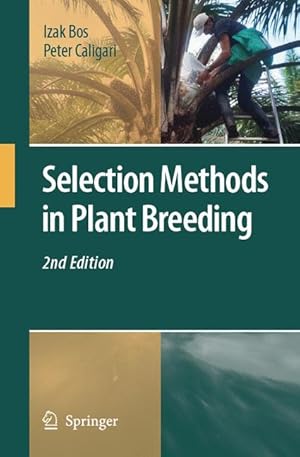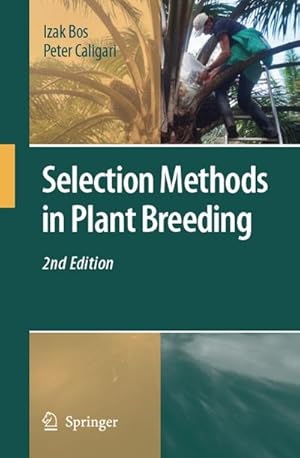9781402063695 - Selection Methods in Plant Breeding de Bos, Izak; Caligari, Peter (6 resultados)
ComentariosFiltros de búsqueda
Tipo de artículo
- Todos los tipos de productos
- Libros (6)
- Revistas y publicaciones (No hay ningún otro resultado que coincida con este filtro.)
- Cómics (No hay ningún otro resultado que coincida con este filtro.)
- Partituras (No hay ningún otro resultado que coincida con este filtro.)
- Arte, grabados y pósters (No hay ningún otro resultado que coincida con este filtro.)
- Fotografías (No hay ningún otro resultado que coincida con este filtro.)
- Mapas (No hay ningún otro resultado que coincida con este filtro.)
- Manuscritos y coleccionismo de papel (No hay ningún otro resultado que coincida con este filtro.)
Condición Más información
- Nuevo (6)
- Como nuevo, Excelente o Muy bueno (No hay ningún otro resultado que coincida con este filtro.)
- Bueno o Aceptable (No hay ningún otro resultado que coincida con este filtro.)
- Regular o Pobre (No hay ningún otro resultado que coincida con este filtro.)
- Tal como se indica (2)
Encuadernación
- Todas
- Tapa dura (6)
- Tapa blanda (No hay ningún otro resultado que coincida con este filtro.)
Más atributos
- Primera edición (No hay ningún otro resultado que coincida con este filtro.)
- Firmado (No hay ningún otro resultado que coincida con este filtro.)
- Sobrecubierta (No hay ningún otro resultado que coincida con este filtro.)
- Con imágenes (4)
- No impresión bajo demanda (4)
Idioma (1)
Precio
- Cualquier precio
- Menos de EUR 20 (No hay ningún otro resultado que coincida con este filtro.)
- EUR 20 a EUR 45 (No hay ningún otro resultado que coincida con este filtro.)
- Más de EUR 45
Gastos de envío gratis
- Envío gratis a España (No hay ningún otro resultado que coincida con este filtro.)
Ubicación del vendedor
Valoración de los vendedores
-
EUR 250,82
Convertir monedaEUR 5,16 gastos de envío desde Reino Unido a EspañaCantidad disponible: Más de 20 disponibles
Añadir al carritoCondición: New. In.
-
Selection Methods in Plant Breeding
Publicado por Springer Netherlands, Springer Netherlands, 2007
ISBN 10: 1402063695 ISBN 13: 9781402063695
Idioma: Inglés
Librería: AHA-BUCH GmbH, Einbeck, Alemania
EUR 270,70
Convertir monedaEUR 11,99 gastos de envío desde Alemania a EspañaCantidad disponible: 1 disponibles
Añadir al carritoBuch. Condición: Neu. Druck auf Anfrage Neuware - Printed after ordering - Selection procedures used in plant breeding have gradually developed over a very long time span, in fact since settled agriculture was rst undertaken. Nowadays these procedures range from very simple mass selection methods, sometimes applied in an ine ective way, to indirect trait selection based on molecular markers. The procedures di er in costs as well as in genetic - ciency.Incontrasttothegenetice ciency,costsdependonthelocalconditions encountered by the breeder. The genetic progress per unit of money invested varies consequently from site to site. This book considers consequently only the genetic e ciency, i.e. the rate of progress to be expected when applying a certain selection procedure. Ifabreederhasacertainbreedinggoalinmind,aselectionprocedureshould be chosen. A wise choice requires a wellfounded opinion about the response to be expected from any procedure that might be applied. Such an opinion should preferably be based on the most appropriate model when considering the crop and the trait (or traits) to be improved. Sometimes little knowledge is available about the genetic control of expression of the trait(s). This applies particularly in the case of quantitative variation in the traits. It is, therefore, important to be familiar with methods for the elucidation of the inheritance of the traits of interest. This means, in fact, that the breeder should be able to develop population genetic and quantitative genetic models that describe the observed mode of inheritance as satisfactorily as possible.
-
Selection Methods in Plant Breeding
Publicado por Springer Netherlands, Springer Netherlands Nov 2007, 2007
ISBN 10: 1402063695 ISBN 13: 9781402063695
Idioma: Inglés
Librería: buchversandmimpf2000, Emtmannsberg, BAYE, Alemania
EUR 267,49
Convertir monedaEUR 35,00 gastos de envío desde Alemania a EspañaCantidad disponible: 2 disponibles
Añadir al carritoBuch. Condición: Neu. Neuware -Selection procedures used in plant breeding have gradually developed over a very long time span, in fact since settled agriculture was rst undertaken. Nowadays these procedures range from very simple mass selection methods, sometimes applied in an ine ective way, to indirect trait selection based on molecular markers. The procedures di er in costs as well as in genetic - ciency.Incontrasttothegenetice ciency,costsdependonthelocalconditions encountered by the breeder. The genetic progress per unit of money invested varies consequently from site to site. This book considers consequently only the genetic e ciency, i.e. the rate of progress to be expected when applying a certain selection procedure. Ifabreederhasacertainbreedinggoalinmind,aselectionprocedureshould be chosen. A wise choice requires a wellfounded opinion about the response to be expected from any procedure that might be applied. Such an opinion should preferably be based on the most appropriate model when considering the crop and the trait (or traits) to be improved. Sometimes little knowledge is available about the genetic control of expression of the trait(s). This applies particularly in the case of quantitative variation in the traits. It is, therefore, important to be familiar with methods for the elucidation of the inheritance of the traits of interest. This means, in fact, that the breeder should be able to develop population genetic and quantitative genetic models that describe the observed mode of inheritance as satisfactorily as possible.Springer Verlag GmbH, Tiergartenstr. 17, 69121 Heidelberg 476 pp. Englisch.
-
EUR 385,78
Convertir monedaEUR 11,49 gastos de envío desde Reino Unido a EspañaCantidad disponible: 2 disponibles
Añadir al carritoHardcover. Condición: Brand New. 2nd edition. 461 pages. 9.25x6.00x1.25 inches. In Stock.
-
Selection Methods in Plant Breeding
Librería: moluna, Greven, Alemania
EUR 223,97
Convertir monedaEUR 19,49 gastos de envío desde Alemania a EspañaCantidad disponible: Más de 20 disponibles
Añadir al carritoCondición: New. Dieser Artikel ist ein Print on Demand Artikel und wird nach Ihrer Bestellung fuer Sie gedruckt. Concise text on population and quantitative genetic theoryComprehensive treatment of selection methods for qualitative and quantitative traitsExtensive treatment of problems due to soil heterogeneity and intergenotypic competition.
-
Selection Methods in Plant Breeding
Publicado por Springer Netherlands Nov 2007, 2007
ISBN 10: 1402063695 ISBN 13: 9781402063695
Idioma: Inglés
Librería: BuchWeltWeit Ludwig Meier e.K., Bergisch Gladbach, Alemania
EUR 267,49
Convertir monedaEUR 11,00 gastos de envío desde Alemania a EspañaCantidad disponible: 2 disponibles
Añadir al carritoBuch. Condición: Neu. This item is printed on demand - it takes 3-4 days longer - Neuware -Selection procedures used in plant breeding have gradually developed over a very long time span, in fact since settled agriculture was rst undertaken. Nowadays these procedures range from very simple mass selection methods, sometimes applied in an ine ective way, to indirect trait selection based on molecular markers. The procedures di er in costs as well as in genetic - ciency.Incontrasttothegenetice ciency,costsdependonthelocalconditions encountered by the breeder. The genetic progress per unit of money invested varies consequently from site to site. This book considers consequently only the genetic e ciency, i.e. the rate of progress to be expected when applying a certain selection procedure. Ifabreederhasacertainbreedinggoalinmind,aselectionprocedureshould be chosen. A wise choice requires a wellfounded opinion about the response to be expected from any procedure that might be applied. Such an opinion should preferably be based on the most appropriate model when considering the crop and the trait (or traits) to be improved. Sometimes little knowledge is available about the genetic control of expression of the trait(s). This applies particularly in the case of quantitative variation in the traits. It is, therefore, important to be familiar with methods for the elucidation of the inheritance of the traits of interest. This means, in fact, that the breeder should be able to develop population genetic and quantitative genetic models that describe the observed mode of inheritance as satisfactorily as possible. 476 pp. Englisch.






